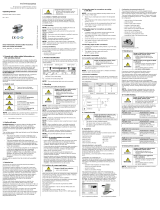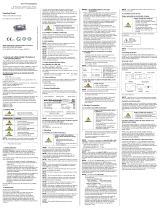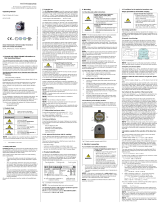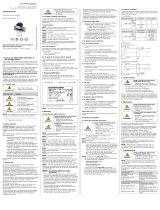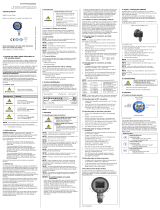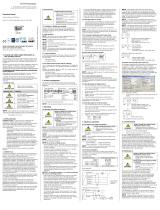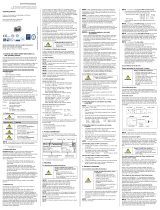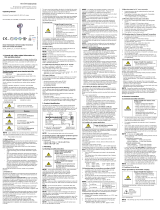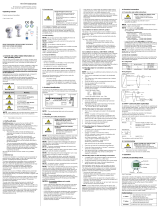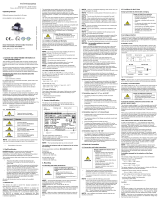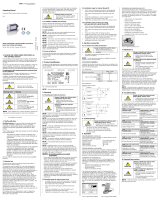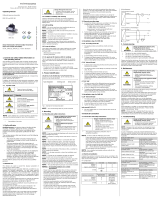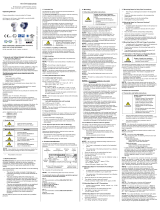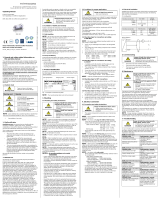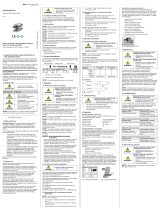Page is loading ...

BD-Sensors-Str.1; 95199 Thierstein, Germany
Phone: +49 (0) 92 35 / 98 11 0 | www.bdsensors.de
© 2019 BD|SENSORS GmbH - All rights reserved.
Operating Manual
Hammer Union Pressure Transmitters for IS-areas
DX18 HU 300, DX18 HU 400
READ THOROUGHLY BEFORE USING THE DEVICE
KEEP FOR FUTURE REFERENCE
ID: BA_HU 300-400_Ex_E | Version: 10.2019.0
1. General and Safety-Related Information on
this Operating Manual
This operating manual enables safe and proper handling of the
product, and forms part of the device. It should be kept in close
proximity to the place of use, accessible for staff members at
any time.
All persons entrusted with the mounting, installation, putting into
service, operation, maintenance, removal from service, and
disposal of the device must have read and understood the
operating manual and in particular the safety-related information.
The following documents are an important part of the
operating manual:
- Data sheet
- Type-examination certificate
For specific data on the individual device, please refer to the
respective data sheet.
Download this by accessing www.bdsensors.de
or request it by e-mail or phone: inf[email protected]
phone: +49 (0) 92 35 / 98 11 0
The IS versions of our products are variants of the standard
products.
In addition, the applicable accident prevention regulations,
safety requirements, and country-specific installation standards
as well as the accepted engineering standards must be
observed.
For the installation, maintenance and cleaning of the device, the
relevant regulations and provisions on explosion protection
(VDE 0160, VDE 0165 and/or EN 60079-14) as well as the
accident prevention regulations must absolutely be observed.
The device was designed by applying the following standards:
EN60079-0:2012
EN60079-11:2012
EN60079-26:2007
1.1 Symbols Used
Warning word
- Type and source of danger
- Measures to avoid the danger
Warning word Meaning
DANGER
- Imminent danger!
- Non-compliance will result in
death or serious injury.
WARNING
- Possible danger!
- Non-compliance may result in
death or serious injury.
CAUTION
- Hazardous situation!
- Non-compliance may result in
minor or moderate injury.
NOTE - draws attention to a possibly hazardous situation that
may result in property damage in case of non-compliance.
Precondition of an action
1.2 Staff Qualification
Qualified persons are persons that are familiar with the
mounting, installation, putting into service, operation,
maintenance, removal from service, and disposal of the
product and have the appropriate qualification for their
activity.
This includes persons that meet at least one of the following
three requirements:
- They know the safety concepts of metrology and
automation technology and are familiar therewith as
project staff.
- They are operating staff of the measuring and
automation systems and have been instructed in the
handling of the systems. They are familiar with the
operation of the devices and technologies described
in this documentation.
- They are commissioning specialists or are employed
in the service department and have completed
training that qualifies them for the repair of the
system. In addition, they are authorized to put into
operation, to ground, and to mark circuits and
devices according to the safety engineering
standards.
All work with this product must be carried out by qualified
persons!
1.3 Intended Use
The devices are used to convert the physical parameter of
pressure into an electric signal.
The pressure transmitter HU 300 has been especially developed
for extreme operating conditions in the petrochemical industry
(on- and offshore sites).
This operating manual applies to devices with explosion
protection approval and is intended for the use in IS-areas.
A device has an explosion-protection approval if this was
specified in the purchase order and confirmed in our order
acknowledgement. In addition, the manufacturing label includes
a sign.
The user must check whether the device is suited for the
selected use. In case of doubt, please contact our sales
department: [email protected] | phone: +49 (0) 92 35 / 98 11 0
BD|SENSORS assumes no liability for any wrong selection and
the consequences thereof!
Permissible media are gases or liquids, which are compatible
with the media wetted parts described in the data sheet.
The technical data listed in the current data sheet are engaging
and must absolutely be complied with. If the data sheet is not
available, please order or download it from our homepage:
http://www.bdsensors.de
WARNING
Danger through incorrect use
- In order to avoid accidents, use the
device only in accordance with its
intended use.
1.4 Limitation of Liability and Warranty
Failure to observe the instructions or technical regulations,
improper use and use not as intended, and alteration of or
damage to the device will result in the forfeiture of warranty
and liability claims.
1.5 Safe Handling
NOTE - Do not use any force when installing the device to
prevent damage of the device and the plant!
NOTE - Treat the device with care both in the packed and
unpacked condition!
NOTE - The device must not be altered or modified in any way.
NOTE - Do not throw or drop the device!
NOTE - Excessive dust accumulation (over 5 mm) and
complete coverage with dust must be prevented!
NOTE - The device is state-of-the-art and is operationally
reliable. Residual hazards may originate from the device if it is
used or operated improperly.
1.6 Safety-Related Maximum Values
The supply connections have an inner capacity of max. 27 nF to
the housing.
application in zone 0 (patm 0.8 bar up to 1.1 bar): -20 ... 60 °C
application in zone 1 and higher: -25 ... 70 °C
DX18 HU 300
Ui = 28 V; Ii = 100 mA; Pi = 700 mW; Ci ≤ 1 nF; Li ≤ 5 µH;
plus cable inductivities 1 µH/m and
cable capacities 150 pF/m (for cable by factory)
DX18 HU 400
Ui = 28 V; Ii = 93 mA; Pi = 660 mW; Ci ≤ 0 nF; Li ≤ 0 µH
1.7 Scope of Delivery
Check that all parts listed in the scope of delivery are included
free of damage, and have been delivered according to your
purchase order:
- Hammer Union pressure transmitter
- this operating manual
2. Product Identification
The device can be identified by means of the manufacturing
label with order code. The most important data can be gathered
therefrom.
Fig. 1: Example of manufacturing label
NOTE - The manufacturing label must not be removed!
The marking for devices with explosion-protection approval
has to include following information:
EC-type examination certificate IBExU08ATEX1127 X
Designation:
DX18 HU 300: II 1/2G Ex ia IIC T4 Ga/Gb
DX18 HU 400: II 1G Ex ia IIC T4 Ga
3. Mounting
3.1 Mounting and Safety Instructions
DANGER
Danger of death from explosion,
airborne parts, leaking fluid, electric
shock
- Always mount the device in a
depressurized and de-energized
condition!
- Do not install the device while there is
a risk of explosion.
DANGER
Danger of death from improper
installation
- Installation must be performed only by
appropriately qualified persons who
have read and understood the user
manual.
NOTE - The technical data listed in the EC-type examination
certificate are binding. Download this by accessing
www.bdsensors.de or request it by e-mail or phone:
[email protected] | phone: +49 (0) 92 35 / 98 11 0
NOTE - Make sure that the entire interconnection of
intrinsically safe components remains intrinsically safe. The
owner-operator is responsible for the intrinsic safety of the
overall system (entire circuitry).
NOTE - Make sure that an equipotential bonding is in place for
the entire course of the line, both in-side and outside the intrinsic
area.
NOTE - If there is increased risk of damage to the device by
lightning strike or overvoltage, increased lightning protection
must additionally be provided!
NOTE - Treat any unprotected diaphragm with utmost care;
this can be damaged very easily.
NOTE - Provide a cooling line when using the device in steam
piping.
NOTE - Do not mount the device in a pneumatic flow rate!
NOTE - When installing the device, avoid high mechanical
stresses on the pressure port! This will result in a shift of the
characteristic curve or to damage.
NOTE - In hydraulic systems, position the device in such a
way that the pressure port points upward (ventilation).
NOTE - If the device is installed with the pressure port pointing
upwards, ensure that no liquid drains off on the device. This
could result in humidity and dirt blocking the gauge reference in
the housing and could lead to malfunctions. If necessary, dust
and dirt must be removed from the edge of the screwed joint of
the electrical connection.
NOTE - Do not remove the packaging or protective caps of the
device until shortly before the mounting procedure. Protective
caps must be kept! Dispose of the packaging properly!
NOTES - for mounting outdoors or in a moist
environment:
- Please note that your application does not show a dew point,
which causes condensation and can damage the pressure
transmitter. There are specially protected pressure
transmitters for these operating conditions. Please contact us
in such case.
- Connect the device electrically straightaway after mounting or
prevent moisture penetration, e.g. by a suitable protective
cap. (The ingress protection specified in the data sheet
applies to the connected device.)
- Select the mounting position such that splashed and
condensed water can drain off. Stationary liquid on sealing
surfaces must be excluded!
- If the device has a cable outlet, the outgoing cable must be
routed downwards. If the cable needs to be routed upwards,
this must be done in an initially downward curve.
3.2 Mounting Steps for WECO
DANGER
Danger of injury
- Due to wrong installation
- Mount the pressure port according to
the manufacturer's specifications of
your WECO connection.
4. Electrical Connection
4.1 Connection and Safety Instructions
DANGER
Danger of death from electric shock
or explosion
- Explosion hazard if the operating
voltage is too high (max. 28 VDC) or
for DX18 HU 400 by opening the field
housing while an explosion hazard
exists.
- Always mount the device in a
depressurized and de-energized
condition!
- Do not install the device while there is
a risk of explosion.
- Operate the device only within the
specification! (according data sheet
EC-type examination certificate)
The limit values listed in the EC-type examination certificate
are observed. (Capacity and inductance of the connection
cable are not included in the values.)
The supply corresponds to protection class III
(protective insulation).
The devices connecting cable has been installed tightly and
is fixed by the appropriate fastening material.
NOTE - for devices with cable outlet
- When routing the cable, following bending radiuses have to
be complied with:
cable without ventilation tube:
static installation: 8-fold cable diameter
dynamic application: 12-fold cable diameter
cable with ventilation tube:
static installation: 10-fold cable diameter
dynamic application: 20-fold cable diameter
- In case of devices with cable outlet and integrated
ventilation tube, the PTFE filter located at the cable end on
the air tube must neither be damaged nor removed! Route
the end of the cable into an area or suitable connection box
which is as dry as possible and free from aggressive gases,
in order to prevent any damage.
- For a clear identification, the intrinsically safe cables are
marked with light blue shrink tubing (over the cable
insulation). If the cable has to be modified (e. g. shortened)
and the marking at the cable end has been lost in the
process, it must be restored (for example, by marking it
again with light blue shrink tubing or an appropriate
identification sign).
NOTE - for DX18 HU 400 with field housing:
- The terminal clamps are situated under the metal cap. To
install the device electrically, the cap must be screwed off.
The connection must be made such that the isolation
distances according to standard are observed and that
loosening of the connecting lines is impossible.
- It must be ensured that the external diameter of the cable
used is within the permissible clamping range
(code 880: Ø 5 … 14 mm). Moreover you have to ensure
that it lies in the cable gland firmly and cleftlessly!
- Before the cap is screwed on again, the O-ring and the
sealing surface on the housing have to be checked for
damages and if necessary to be changed! Afterwards
screw the metal cap on by hand and make sure that the
field housing is firmly locked again.
NOTE - Use a shielded and twisted multicore cable for the
electrical connection.
4.2 Conditions for the IS-area
Danger generated by electrostatic charging
DANGER
Danger of death from explosion
- Explosion hazard due to spark
formation from electrostatic charging
of plastic components.
- For devices with cable outlet, the cable
must be installed tightly.
- Do not clean the device and, if
applicable, the connection cable, in a
dry state! Use a moist cloth, for
example.
The following warning sign is affixed on devices with plastic
components.
Fig. 2: Warning sign
NOTE - The warning sign must not be removed from the
device!
Overvoltage protection
If the pressure transmitter is used as electrical equipment of
category 1 G or 2 G, then a suitable overvoltage protection
device must be connected in series (attend the valid regulations
for operating safety as well as EN60079-14).
Schematic circuit
The operation of an intrinsically safe transmitter in intrinsic safe
areas requires special care when selecting the necessary Zener
barrier or transmitter repeater devices to allow the utilization of
the device’s properties to the full extent. The following diagram
shows a typical arrangement of power supply, Zener barrier and
transmitter.
Fig. 3 circuit diagrams
NOTE - Observe item (17) of the type-examination certificate
which specifies special conditions for intrinsically safe operation.
Exemplary circuit description
The supply voltage of e.g. 24 VDC provided by the power supply
is led across the Zener barrier. The Zener barrier contains series
resistances and breakdown diodes as protective components.
Subsequently, the operating voltage is applied to the transmitter
and, depending on the pressure, a particular signal current
flows.
DANGER
Danger of death from explosion
- Operation of intrinsically safe devices
as zone-0 equipment only with
ungrounded and galvanically isolated
power supply.
Functional selection criteria for Zener barriers and
galvanic power supply
The minimum supply voltage VS min of the transmitter must not
fall short since a correct function of the device can otherwise not
be guaranteed. The minimum supply voltage has been defined
in the respective product-specific data sheet under "Output
signal / supply".
When using a galvanically insulated amplifier with linear
bonding, note that the terminal voltage of the transmitter will
decrease like it does with a Zener barrier. Furthermore, you
have to note that the supply will additionally decrease with an
optionally used signal amplifier.
Test criteria for the selection of the Zener barrier
In order not to fall below VS min, it is important to verify which
minimum supply voltage is available at full level control of the
transmitter. The full level control, i.e. a maximum or nominal
output signal (20 mA), can be reached by applying the maximum
physical input signal (pressure).
The technical data of the barrier will usually provide the
information needed for the selection of the Zener barrier.
However, the value can also be calculated. If a maximum signal
current of 0.02 A is assumed, then – according to Ohm’s law – a
particular voltage drop will result from the series resistance of
the Zener barrier.
This voltage drop is subtracted by the voltage of the power
supply and as a result, the terminal voltage is obtained which is
applied on the transmitter at full level control. If this voltage is
smaller than the minimum supply voltage, another barrier or a
higher supply voltage should be chosen.
NOTE - When selecting the ballasts, the maximum operating
conditions according to the EC type-examination certificate must
be observed. When assessing these, refer to their current data
sheets to ensure that the entire interconnection of intrinsically
safe components remains intrinsically safe.
NOTE for HU 400 – When selecting the barrier or power
supply, you must look out for any ballasts which are not suitable
for HART communication. Most manufacturers offer a device
group specially developed for this application.
Calculation example for the selection of the Zener
barrier
The nominal voltage of the power supply in front of the Zener
barrier is 24 VDC ± 5 %. This results in:
- maximum supply voltage:
VSup max = 24 V * 1.05 = 25.2 V
- minimum supply voltage:
VSup min = 24 V * 0.95 = 22.8 V
The series resistance of the Zener barrier is listed with 295 ohm.
The following values must still be calculated:
- voltage drop at the barrier (with full conduction):
V
ab barrier = 295 * 0.02 A = 5.9 V
- terminal voltage at the transmitter with Zener barrier:
V
Kl = VS up min – Vab Barriere = 22.8 V – 5.9 V = 16.9 V
- minimum supply voltage of the transmitter:
V
Kl min corresponding to VS min (according to data sheet)
Condition:
V
Kl ≥ VKl min
Result:
The terminal voltage of the transmitter with Zener barrier lies at
16.9 V and is therefore higher than the minimum supply voltage
of the transmitter. This means, the Zener barrier has been
selected correctly regarding the supply voltage.
NOTE - Note that no line resistances have been listed in this
calculation. However, these will lead to an additional voltage
drop that must be taken into account.
EC-type examination certificate no.,
explosion marking
Safety technical
maximum values
Type designation Ordering code Serial number
transmitter +VS
VS
Zener barrier +VS
-VS
power suppl
y
transmitter amplifier supply
shielded cable
IS-area secure area
DX18 HU 400:
0637

4.3 Electrical Installation
Establish the electrical connection of the device according to the
technical data shown on the manufacturing label, the following
table and the wiring diagram.
DX18 HU 300
Pin configuration:
Electrical
connections MIL / Bendix
(6-pin)
Glenair
(4-pin)
cable
colours
(IEC 60757)
Supply +
Supply
Calibration +
Calibration -
pin A
pin B
pin E
pin F
pin C
pin B
pin D
pin A
WH (white)
BN (brown)
PK (pink)
GY (grey)
Shield cable shield /
pin D
plug
housing
GNYE
(green / yellow)
Wiring diagrams:
2-wire-system (current) MIL / Bendix
2-wire-system (current) Glenair
Obtaining an 80 % calibration signal:
For producing an 80 % calibration signal, please apply in
pressureless mode a voltage of min. 5 V to the connections
CAL+ and CAL-. The max. voltage has to be equated with the
device’s max. allowed operating voltage. By applying the voltage
to CAL+ and CAL-, an additional current of 12.8 mA is issued,
resulting in a total current of 16.8 mA. For Ex devices, it has to
be observed that the same source of supply has to trigger the
calibration signal and supply the signal circuit.
DX18 HU 400
Pin configuration:
Electrical connection field housin
g
M20x1.5
Pressure
Supply P+
Supply P–
IN+
IN-
Shield
Temperature
Supply T+
Supply T+
Supply T–
T+
T+
T-
Wiring diagrams:
2-wire system (Strom)
wiring diagrams Pt100 / Pt1000 3-wire system
Connection technique
Hereby two measuring circuits are established. By the third wire
it is possible to find out and to compensate the resistance of
wire.
5. HART communication with DX18 HU 400
DANGER
Danger of death from explosion
- when interrupting the intrinsically safe
circuit where an explosion hazard
exists
- Only interrupt the intrinsically safe
circuit for looping-in a HART
communication interface (HART
Communicator or HART Modem)
when no explosion hazard is present.
An additional signal as per HART specification is superimposed
on the analogue output signal. The device may be configured by
means of a HART communication device. In this regard, we
recommend the CIS 150 programming kit (available as
accessory).
In order to ensure trouble-free operation, the following
requirements must be taken into account:
Maximum cable length between measuring device and supply:
VVV CCR
L36
max
10401065
Wherein Lmax: maximum length of cable in [m]
R
V: resistance of cable together with load
resistance in []
C
V: capacity of cable in [pF/m]
Resistance R:
024,0
12U
R
wherein U: supply in [VDC]
The resistance must be at least 240 .
6. Commissioning
DANGER
Danger of death from explosion
- Explosion hazard if the operating
voltage is too high (max. 28 VDC)!
- Operate the device only within the
specification! (according to data sheet)
The device has been installed properly.
The device does not have any visible defect.
The device is operated within the specification.
(see data sheet and EC type-examination certificate).
7. Maintenance
DANGER
Danger of death from airborne parts,
leaking fluids, electric shock
- Always service the device in a
depressurized and de-energized
condition!
WARNING
Danger of injury from aggressive fluids
or pollutants
- Depending on the measured medium,
this may constitute a danger to the
operator.
- Wear suitable protective clothing
e.g. gloves, safety goggles.
If necessary, clean the housing of the device using a
moist cloth and a non-aggressive cleaning solution.
The cleaning medium for the media wetted parts (pressure port/
diaphragm/seal) may be gases or liquids which are compatible
with the selected materials. Also observe the permissible
temperature range according to the data sheet.
Deposits or contamination may occur on the diaphragm/
pressure port in case of certain media. Depending on the quality
of the process, suitable maintenance intervals must be specified
by the operator. As part of this, regular checks must be carried
out regarding corrosion, damage to the diaphragm and signal
shift.
If the diaphragm is calcified, it is recommended to send the
device to BD SENSORS for decalcification. Please note the
chapter “Service/Repair” below.
NOTE – Wrong cleaning or improper touch may cause an
irreparable damage on the diaphragm. Therefore, never use
pointed objects or pressured air for cleaning the diaphragm
8. Troubleshooting
DANGER
Danger of death from airborne parts,
leaking fluids, electric shock
- If malfunctions cannot be resolved, put
the device out of service.
DANGER
Danger of death from explosion
- As a matter of principle, work on
energized parts, except for intrinsically
safe circuits, is prohibited while there is
an explosion hazard.
In case of malfunction, it must be checked whether the device
has been correctly installed mechanically and electrically. Use
the following table to analyse the cause and resolve the
malfunction, if possible.
Fault: no output signal
Possible cause Fault detection / remedy
Connected incorrectly Checking of connections
Conductor/wire breakage Checking of all line
connections.
Defective measuring device
(signal input)
Checking of ammeter
(miniature fuse) or of analogue
input of your signal processing
unit
Fault: analogue output signal too low
Possible cause Fault detection / remedy
Load resistance too high Checking of load resistance
(value)
Supply voltage too low Checking of power supply
output voltage
Defective energy supply
Checking of the power supply
and the supply voltage being
applied to the device
Fault: slight shift of the output signal
Possible cause Fault detection / remedy
Diaphragm of senor is
severely contaminated,
calcified or crusted
Checking of diaphragm; if
necessary, send the device to
BD|SENSORS for cleaning
Fault: large shift of the output signal
Possible cause Fault detection / remedy
Diaphragm of sensor is
damaged (caused by
overpressure or mechanically)
Checking of diaphragm; when
damaged, send the device to
BD|SENSORS for repair
Fault: wrong or no output signal
Possible cause Fault detection / remedy
Cable damaged mechanically,
thermally or chemically
Checking of cable; pitting
corrosion on the stainless-steel
housing as a result of damage
on cable; when damaged, send
the device to BD|SENSORS for
repair
9. Removal from Service
DANGER
Danger of death from airborne parts,
leaking fluids, electric shock
- Disassemble the device in a
depressurized and de-energized
condition!
WARNING
Danger of injury from aggressive
media or pollutants
- Depending on the measured medium,
this may constitute a danger to the
operator.
- Wear suitable protective clothing
e.g. gloves, goggles.
NOTE - After dismounting, mechanical connections must be
fitted with protective caps.
10. Service/Repair
Information on service / repair:
- www.bdsensors.de
- Service phone: +49 (0) 92 35 / 98 11 0
10.1 Recalibration
During the life-time of a transmitter, the value of offset and span
may shift. As a consequence, a deviating signal value in
reference to the nominal pressure range starting point or end
point may be transmitted. If one of these two phenomena occurs
after prolonged use, a recalibration is recommended to ensure
furthermore high accuracy.
10.2 Return
WARNING
Danger of injury from aggressive
media or pollutants
- Depending on the measured medium,
this may constitute a danger to the
operator.
- Wear suitable protective clothing
e.g. gloves, goggles.
Before every return of your device, whether for recalibration,
decalcification, modifications or repair, it has to be cleaned
carefully and packed shatter-proofed. You have to enclose a
notice of return with detailed defect description when sending
the device. If your device came in contact with harmful
substances, a declaration of decontamination is additionally
required.
Appropriate forms can be downloaded from our homepage.
Download these by accessing www.bdsensors.de or request
them:
[email protected] | phone: +49 (0) 92 35 / 98 11 0
In case of doubt regarding the fluid used, devices without a
declaration of decontamination will only be examined after
receipt of an appropriate declaration!
11. Disposal
WARNING
Danger of injury from aggressive
media or pollutants
- Depending on the measured medium,
this may constitute a danger to the
operator.
- Wear suitable protective clothing
e.g. gloves, goggles.
The device must be disposed of according to the
European Directive 2012/19/EU (waste electrical
and electronic equipment). Waste equipment must
not be disposed of in household waste!
NOTE - Dispose of the device properly!
12. Warranty Terms
The warranty terms are subject to the legal warranty period of
24 months, valid from the date of delivery. If the device is used
improperly, modified or damaged, we will rule out any warranty
claim. A damaged diaphragm will not be accepted as a warranty
case. Likewise, there shall be no entitlement to services or parts
provided under warranty if the defects have arisen due to normal
wear and tear.
Pt100 / Pt1000
3-wire passiv
D
E
A
F
B
CAL+
S+
CAL─
S─
p
I
VS
A
+
─
D
C
A
B
CAL+
S+
CAL─
S─
p
I
VS
A
+
─
13. Declaration of conformity / CE
The delivered device fulfils all legal requirements. The applied directives, harmonised standards and documents are listed in the
EC declaration of conformity, which is available online at: http://www.bdsensors.de. Additionally, the operational safety is confirmed
by the CE sign on the manufacturing label.
/
